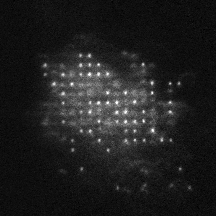July 20, 2007 feature
Trapped, Imaged Single Atoms May Enable Powerful Quantum Computing

Quantum computers have the potential to vastly out-perform present-day “classical” computers – if scientists can identify and manipulate promising quantum bits, or “qubits,” the basic information-storing units of a quantum computer.
Recently, researchers from The Pennsylvania State University trapped and imaged a three-dimensional array of 250 neutral atoms – each a promising qubit. This work could one day form the base for an incredibly powerful quantum computer.
“Atoms are ideal quantum systems,” explains Penn State physicist David Weiss, the experiment's corresponding scientist, to PhysOrg.com. “We have shown that we can trap hundreds of isolated atoms in such a way that it should be possible to individually address them, making each of them a qubit. It may be a long road from here to a useful quantum computer, but we can already see quite far down that road.”
Weiss and his group, including postdoctoral researcher Karl Nelson and graduate student Xiao Li, who performed the work, say that a quantum computer consisting of even 50 qubits could perform simulations way beyond those of current computers. Prior to their work, however, fewer than ten atoms had been imaged simultaneously nor had scientists successfully used light to trap and image either single atoms or atom bunches into three-dimensional “optical lattices.”
The optical lattice this research group created results from three overlapping laser-beam pairs and traps cold neutral cesium atoms. The beams restrict the atoms tightly in all three directions and lock them into a cubic array, with equal spacing between each atom. This occurs due to the interference pattern produced by the crossed beams; that is, how the light waves add and cancel each other, resulting in a regular cubic grid of maxima (bright spots) and minima (dark spots). The atoms are trapped in the minima.
Weiss and his colleagues imaged the lattice plane by plane, taking photographs of each layer. The photos show that the light used to image the array is highly unlikely to cause atoms to hop around in the lattice, a requirement if this type of atom arrangement could be one day used in a quantum computer. The researchers also assert that the spacing between each atom should be large enough such that individual atoms can be manipulated. By combining this ability with the ability to repeatedly image the array without disrupting it, the scientists think they have the basic ingredients for workable qubits. Their method could be used to create optical lattices containing thousands of atoms.
However, warns Weiss, “I don't want to understate the technical challenge of building a large quantum computer with our approach, or any other approach.”
Citation: Karl D. Nelson, Xiao Li and David S. Weiss, “Imaging single atoms in a three-dimensional array.” Nature Physics advance online publication DOI:10.1038/nphys645
Copyright 2007 PhysOrg.com.
All rights reserved. This material may not be published, broadcast, rewritten or redistributed in whole or part without the express written permission of PhysOrg.com.





















